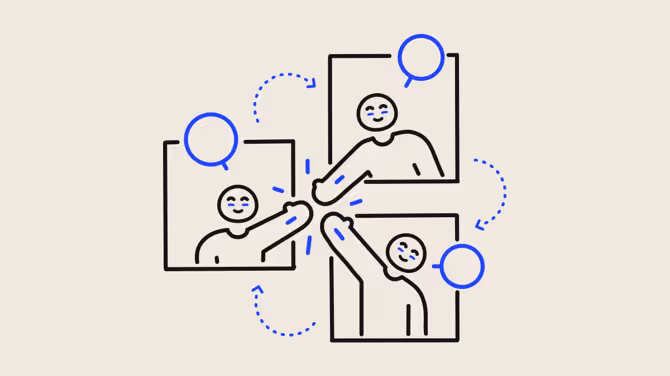5 Tips to promote authenticity at work, and be a more authentic leader

From flawed to flawless: 5 steps to leading distributed teams

People do their best work when they’re free to be themselves. And for people to feel that freedom to be themselves (yourself included), you need to create an environment that fosters and supports authenticity at work. This is what will take your team to the next level in their collaboration, innovation, and performance.
But what, exactly, is authenticity at work? Why is it so important? And how can you create a more authentic workplace—both for yourself and for your team?
What is authenticity at work?
Authenticity at work is being able to show up as your true, authentic self in the workplace. That can manifest in a few different ways, including:
Showing your personality and being yourself
First and foremost, authenticity at work means being yourself, and showing your true colours. That means not feeling like you have to act a certain way or be someone you’re not. In a world where home and work are blended, this is as important as ever. It’s tiring trying to separate a work persona from an outside-of-work one.
Having a sense of psychological safety
When you have psychological safety on your team, people feel comfortable speaking their mind, making mistakes, and being candid in their interactions with colleagues. This makes space for people to point out potential risks or blockers without feeling like they’re shutting their peers down, and share challenging feedback from a place of compassion.
Being valued for who you are and what you bring
Authenticity is also about being appreciated and valued for the true self you show up as. And beyond being embraced for who they are by their team, employees want to feel that their contributions, ideas, and opinions are valued. Bottom line, people want to feel respected for who they are. Yet, according to Officevibe’s Pulse Survey data…
What does this tell us? There could be a number of reasons for this disconnect, but the point is people perceive their own behaviour differently from how those around them do. This is why stating (and restating) that everyone is safe, welcome, and valued on your team is so important.
Authentic management
As a manager, it’s just as important to manage your team authentically. This is where creating a work environment that welcomes and promotes authenticity starts. It’s important to make sure your team members feel seen and valued for who they are, and not just what they contribute to the team. But the really tough part? Showing that authenticity yourself by owning your mistakes, bringing up your own questions, and celebrating your own wins.
What are the benefits of authenticity at work?
A team and company culture that values authenticity at work has a variety of benefits, including…
- Happier employees: People who feel like they can be themselves in the workplace are happier. And when employees are happy at work, employee engagement, team productivity, and overall motivation goes up.
- Stronger teams: When people feel seen and appreciated for their authentic selves, they form stronger bonds. This leads to better collaboration and higher-performing teams.
- More effective feedback: The safety to be candid with colleagues means people are less afraid to share their true opinions and insights. This leads to more honest, valuable feedback that helps people grow and do their best work.
- More innovation: When people can be authentic at work, they’re not afraid to share ideas or make mistakes. They’re more likely to take (calculated) risks and be creative, which leads to more innovation.
How to be an authentic leader
Authenticity at work starts with authentic leaders. When teams see their managers being authentic, it not only builds trust, but also gives them permission to show up more authentically. So, if you want your team to be more authentic, you need to start with being more authentic yourself.
1. Don’t be afraid to be yourself
A lot of managers think they have to act a certain way to get respect from their teams. You might think you have to be super professional, serious, or closed off. But being authentically yourself can go a long way in building stronger relationships, and deepening respect and mutual understanding. So look for ways to inject your authentic self into your work life.
{emphasize}
For example: You might share some of the things that are important to you outside of work with your team. Whether it’s your family, your pets, or a favorite hobby, spark conversations outside of deliverables. You might discuss current events (and your feelings about them), or bring your personal values, beliefs, and motivators into team discussions.
{emphasize}
2. Show your team it’s ok to make mistakes
When you show your team that not only is it ok to make mistakes, but that mistakes are actually an opportunity for positive growth, it gives them permission to make mistakes, too. Why is this important? People will be honest and own up to things when mistakes happen, and not sweep it under the rug or try to hide it. That means better solutions will be put into place more quickly, because you and your team will be there for support.
{emphasize}
For example: Say you waited until the last minute to assign certain project-related tasks. As a result, your team now has too much on their plate, and too tight of a deadline. Instead of just pledging to yourself to do better next time, acknowledge your mistake with your team, and let them know how you plan to handle it better in the future. Whether that means being more proactive to give them at least two weeks notice when assigning a new task, or helping them reprioritize when urgent things pop up to help reduce overwhelm.
{emphasize}
Tips to encourage authenticity on your team
Being an authentic manager is a great way to lead by example. But if you want to reap all the benefits of an authentic workplace, you also need to foster a culture of authenticity on your team.
3. Encourage productive discussions
How we communicate is a big part of authenticity at work; your team needs to feel safe and supported in speaking their mind and sharing their thoughts, ideas, and opinions. To promote this kind of culture on your team, you have to create space for more candid discussions.
Let your team know that you want them to share their opinions—even if those opinions might challenge your ideas, goals, or direction for the team. When your employees do share their opinions, engage with them enthusiastically. That way, they’re encouraged to share more authentic opinions in the future.
{emphasize}
For example: If someone shares an idea that isn’t going to necessarily work for your team, use it as a jumping off point, and turn it into a conversation. Let it spark a discussion and encourage your other team members to engage and build on the idea. Watch as they pinpoint problems and seek out alternatives, and let them know how impressed you are.
{emphasize}
Continually remind your team that there is always time and space for them to share their thoughts and ideas, even if they’re not always comfortable doing it directly in a one-on-one or team meeting. A private, secure employee feedback platform like Officevibe can make space for real talk, and spark conversations that wouldn’t happen otherwise.
4. Get to know your team members, for real
Authenticity is all about showing up to work as your true self. But if you don’t know those “true selves” on your team, it’s harder to encourage people to bring their whole selves to work every day. That’s why, as a manager, it’s so important to get to know your individual team members. Spend time in one-on-one meetings getting to know your team members. Find out who they are and what makes them tick, and then look for ways to build that into their work.
{emphasize}
For example: If you find out one of your team members does stand-up comedy, give them plenty of opportunities to lead presentations—and to work in a joke or two. If you find out an employee is spending their off-hours working on their first book, make sure you’re creating opportunities for them to show off their writing skills.
{emphasize}
The more you get to know your team members, the more you can create opportunities that speak to who they are—and the more you’ll build a team full of true selves.
5. Create opportunities for your team to show up authentically
Creating work opportunities that speak to who your employees are is a great way to foster authenticity in the workplace. But if you really want your team to feel comfortable being who they are at work, it needs to extend beyond their work duties. As a manager, you need to create opportunities where “who they are” takes center stage—and they can be celebrated for it.
{emphasize}
For example: If your team members are passionate about their hobbies, you might host a team talent show, where each employee gets to show off their hobby/passion/talent to the rest of the team. If you manage a team of enthusiastic readers, you might start a team book club, where you and your team read a book once a quarter and get together over lunch to discuss.
{emphasize}
Bottom line? Creating opportunities at work for employees to show up as their real selves—even (or especially!) if those opportunities aren’t directly tied to your team’s job descriptions—is a great way to encourage authenticity at work.
The best workplaces have teams full of true selves
Being able to show up as your true self and empower your team to do the same is a must for building a more authentic workplace. And authentic workplaces outperform the competition, retain their top talent, and create the conditions for great work.
Give HR and managers the clarity, confidence, and connection to lead better every day.


%20(1).avif)


.avif)
.avif)








